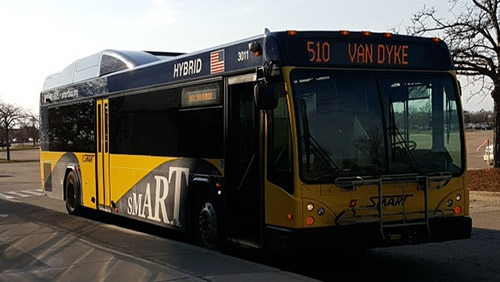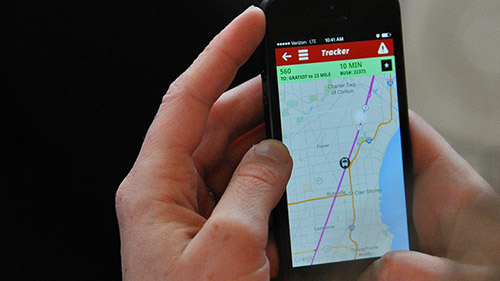Covering 1,100 square miles, 43 routes, and more than 5,000 stops, the Suburban Mobility Authority for Rapid Transit Authority (SMART) operates a fleet of more than 330 biodiesel and hybrid-electric buses. Each day, more than 32,000 seniors, students, and professionals across Michigan’s Macomb, Oakland, and Wayne Counties (90 percent of whom are going to/from work and school) rely on SMART for safe, dependable, affordable transportation.
BUSINESS CHALLENGE

When you have up to 200 buses on the streets for 23 hours each day, it’s essential to constantly monitor your vehicles to ensure the highest levels of on-time performance and safety. For the Suburban Mobility Authority for Rapid Transit (SMART), that challenge was growing increasingly difficult as its automatic vehicle location (AVL) system aged. The AVL uses a radio network to create a two-way communication link between each vehicle and SMART’s operations center where dispatchers can monitor vehicle locations, schedule performance, and other metrics.
“Our AVL was 20 years old,” explained Mel Evans, IT manager for SMART. “We were relying on a legacy analog radio network that used three leased towers and a slice of frequency that was being retired. While this infrastructure was satisfactory 20 years ago, it wasn’t keeping pace with SMART. We wanted more reporting and we wanted real-time information that we could share with our public ridership.”
One option was to upgrade from analog to digital signals and increase the number of towers. Evans noted that this would be cost-prohibitive. “At approximately $1 million each, the upgrade strategy was too expensive for our agency,” he said. “It became clearer that we needed to consider a different strategy that involved an entirely new AVL solution.”
SOLUTION
Aiming to improve its ability to monitor its fleet of vehicles, reduce costs, and move off of the analog frequency, SMART began to evaluate a switch to cellular communication with voice over IP (VoIP). The agency hired a consultant to lead a rigorous evaluation/procurement process, which led SMART to select an AVL solution from Clever Devices, a leading provider of communications and technology solutions for forward-thinking transit agencies.
“Clever Devices had a lot of experience,” said Evans, “and they’d implemented AVL with VoIP for other transit agencies. The heart of the cellular solution they proposed was the Digi TransPort WR44 R cellular router, which we were impressed with.”
The Digi TransPort WR44 R is a rugged, enterprise-class mobile-access router. It is designed specifically for transit agencies and authorities that need reliable communications for onboard systems such as security video, fare collection, CAD/AVL, VoIP dispatch, and passenger Wi-Fi. Priority access is accomplished using the IETF Internet standard for Differentiated Services, which ensures VoIP calls and CAD/AVL functions have sufficient bandwidth across a constrained cellular LTE link. Fare collection and mobile ticketing systems generally require PCI compliance, which the WR44 R provides through its stateful firewall, IPSec VPN, network segmentation, and authentication. And the Digi Remote Manager enables efficient and effective network operations, providing critical functions such as mass updates, configuration profiling, and fleet monitoring with performance metrics reporting and alarms.
BENEFITS
With its switch to a cellular-based AVL, SMART is now able to collect and analyze a much wider range of data and metrics – including vehicle location and speed – in real-time. Maintenance data is also captured to prevent breakdowns and accelerate repair cycles to minimize vehicle downtime. All of that data is transmitted to the operations center through a VPN tunnel. In addition, operators can communicate with Central Dispatch using VoIP handsets. “We have a modern AVL system, with all of the benefits of our previous analog system, but at a lower cost and with new modern features,” said Evans.

For instance, SMART is able to use its real-time AVL data to populate a smartphone/texting app. A passenger can text his bus stop to SMART and receive an instant reply that tells the estimated time before the next bus will arrive. That app is already receiving more than 10,000 queries per month. Perhaps more impressive is the ROI that the agency is already achieving. “Between the rental of space on the tower, maintaining the radio equipment, and the man-hours, we’re easily saving $70,000 per year in hard costs with the Digi-based solution,” Evans said. “But I bet we’re easily saving an additional $150,000-200,000 in the soft costs involved in sending people out to the tower sites, checking backup batteries, and maintaining power generators. This is a great system that is saving money and making our agency more efficient.”